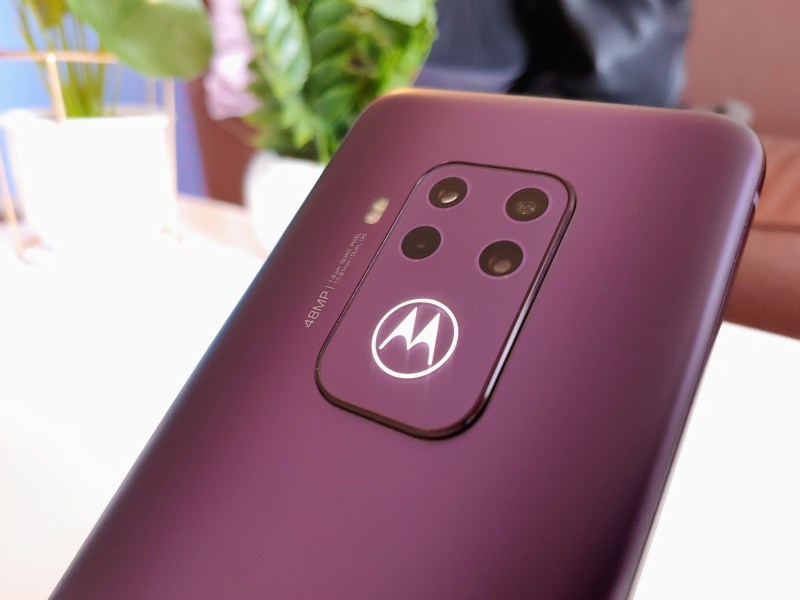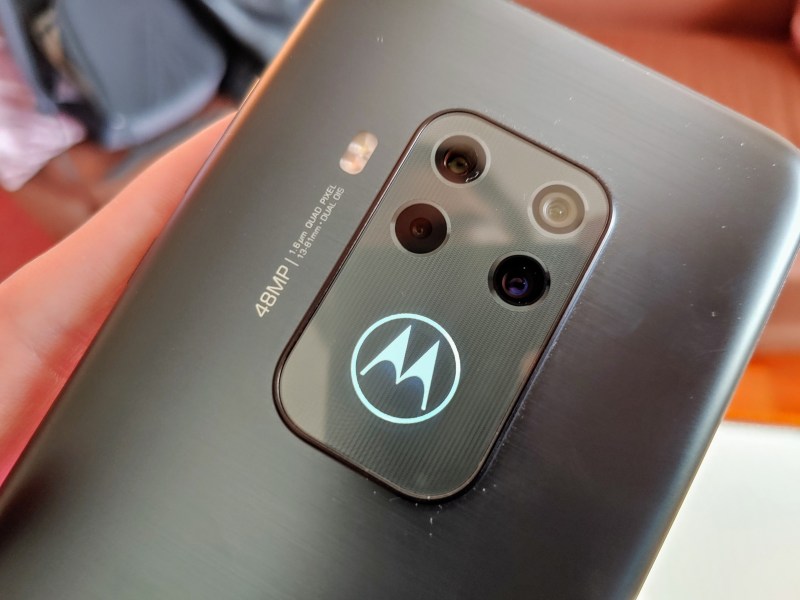In the immortal words of The Pussycat Dolls: “Don’t you wish your smartphone could zoom like mine?” Perhaps we’re paraphrasing, but that seems to be the angle with the new Motorola One Zoom, which Motorola announced today at IFA 2019 in Berlin. The One Zoom joins the One Power and One Action in the Chicago company’s One handset family, and its headlining attraction is undoubtedly the four-sensor camera protruding from its rear.
The One Zoom will hit store shelves globally on September 5 priced at $449.99 (€429.00), exclusively through Motorola’s website. It’ll be unlocked and compatible with GSM carriers like AT&T and T-Mobile, and it’ll come in three colors: gray, purple, and bronze.
Design and hardware
The One Zoom might not be the most attractive smartphone on the block, but it punches above its weight class where durability is concerned. The combination glass and 6000 series aluminum case measures 75 by 158 by 8.8 millimeters and weighs 190 grams, and it sports nano-coating courtesy P2i that protects against water splashes and dust ingress.
The flavor of panel here is OLED, with a 19:9 aspect ratio and a centered U-shaped notch, giving the One Power an 85% screen-to-body ratio all considered. The display is Full HD+ (2,340 by 1,080 pixels) and measures 6.39 inches diagonally, with thin bezels that curve to meet the frame’s lip and 2.5D Panda King glass shielding designed by China-based firm Tunghsu. Worth noting is the optical fingerprint sensor embedded beneath the surface, which Motorola says self-learns and becomes quicker at recognizing prints over time.
June 5th: The AI Audit in NYC
Join us next week in NYC to engage with top executive leaders, delving into strategies for auditing AI models to ensure fairness, optimal performance, and ethical compliance across diverse organizations. Secure your attendance for this exclusive invite-only event.

The notch isn’t just for show. Rather, it houses a 25-megapixel front-facing camera with an f/2.0 aperture and 0.9-micron pixel size. Somewhat novelly, and like the Moto Z4, it optionally leverages proprietary pixel binning technique — Quad Pixel — to combine information from adjacent CMOS pixels and produce “super-pixels” that improve light sensitivity by a factor of four. The only drawback? It outputs the equivalent of a 1.8um pixel size, 6.25-megapixel sensor.
There’s a USB 3.1 (Type C) port near the bottom, adjacent to a 3.5mm headphone jack and the One Zoom’s only speaker. As for the back, it’s mostly barren, save for the rear camera module and 3D Gorilla Glass encasing a glimmering Motorola logo.
Camera
You’d expect a phone with the word “zoom” prominently embossed to deliver in the camera department, and fortunately, we’ve no reason to believe the One Zoom falls short. Its 48-megapixel primary sensor (f/1.7 aperture, 16-micron) taps optical image stabilization and phase detection autofocus to minimize the effects of jostling while locking focus, while the Quad Pixel tech boosts color and contrast, outputting what’s effectively a 12-megapixel image when enabled.
The secondary 16-megapixel camera’s 117-degree field of view makes it better-suited to ultra-wide-angle photography, and the tertiary 8-megapixel camera’s three times telephoto zoom brings faraway objects into sharp relief. Motorola dubbed it “high-res” optical zoom, so called because of the sensor’s blur-minimizing optical image stabilization.

Rounding out the four-sensor array is a 5-megapixel depth sensor, which apps can leverage to capture depth maps of the One Zoom’s surroundings. Said maps enable things like postproduction bokeh (blurred backgrounds and in-focused foregrounds) adjustment, plus superior augmented reality experiences and features.
The One Zoom certainly isn’t wanting for shooting options, if that’s your thing. There’s a spotlight mode — Night Vision — that composites light information from three to six frames captured at varying exposure levels to boost brightness, cut down on noise, and enhance sharpness and color. (It’s akin to Night Sight on Google’s Pixel phones, Huawei’s Night Mode, and Samsung’s Bright Night.) Augmented reality stickers populate the One Zoom’s camera app, as do shortcuts to YouTube Live, a panorama mode, Cinemegraph (which animates part of a picture while the rest remains still), Spot Color (which turns backgrounds black and white), and Google Lens integration.
Performance
Under the hood of the One Zoom, you’ll find a Qualcomm Snapdragon 675 octa-core processor built on an 11-nanometer LLP, paired with 4GB of RAM and 128GB of storage (expandable via microSD card). It’s the same system-on-chip as inside midrange phones like Vivo V15 Pro, Samsung’s Galaxy A70, and Motorola’s own Moto P40 and Moto Z4.
Two Kryo 460 Arm A76-based Gold performance cores clocked at 2GHz handle the heavy lifting, while six A55-based Silver 1.7GHz efficiency cores address less performance-intensive tasks. AI capabilities are diffused among multiple components, chiefly the Hexagon 685 digital signal processor, and there’s a 14-bit Spectra 250 image signal processor onboard that supports still image capture up to 32 megapixels and up to 4K video capture. Elsewhere, the One Zoom sports an Adreno 608 discrete graphics chip and Qualcomm’s X15 modem, which is theoretically capable of reaching download and upload speeds of 600Mbps (LTE Cat. 15) and 150Mbps (LTE Cat. 13), respectively, and works with 802.11 a/b/g/n/ac dual-band (2.4 and 5GHz) Wi-Fi.

Bluetooth 5.0 connectivity is in tow, as is support for GPS, AGPS, GLONASS, and Galileo. Among the other elements of note are a magnetometer, an ultrasonic sensor, and a gyroscope, in addition to a non-removable 4,000mAh battery that’s compatible with Motorola’s 15W TurboPower wall charger and that lasts a quoted two days of mixed usage.
Software
Capable hardware is nothing without great apps to match, and Motorola delivers the goods. Its skin atop Android 9.0 Pie is closer to stock than most, excepting a few genuinely useful touches, like an updated one-button navigation mode that replaces the on-screen navigation buttons with a narrow strip.
Motorola’s handy Moto Display and Moto Actions save time by condensing multiple steps into single taps and swipes. Both allow you to customize behavioral triggers such that the Moto One Zoom can silence notifications and calls when it’s lying face down on a table or stop playing music when the screen dims. Attentive Display keeps the display on while you’re looking at it, and Peek Display — Motorola’s take on Android’s built-in Always On Display — surfaces notifications on the lock screen when the screen is switched mostly off.
The Moto One Zoom recognizes a number of gestures designed to launch apps more quickly than you’d be able to with taps and swipes, like a double twist of the wrist that launches the camera and a chopping motion that switches the camera LED on or off. There’s also Face Unlock, which automatically unlocks the device using photo recognition when you lift the camera up to your face, and “pick up to silence,” which silences the ringer when you lift the phone to your ear.


